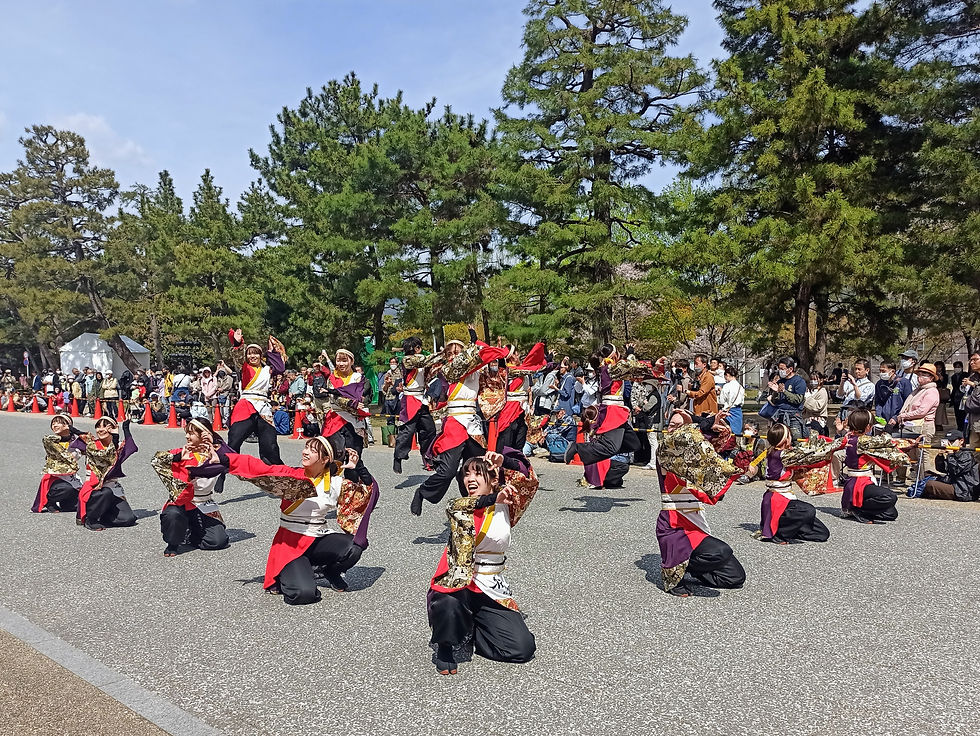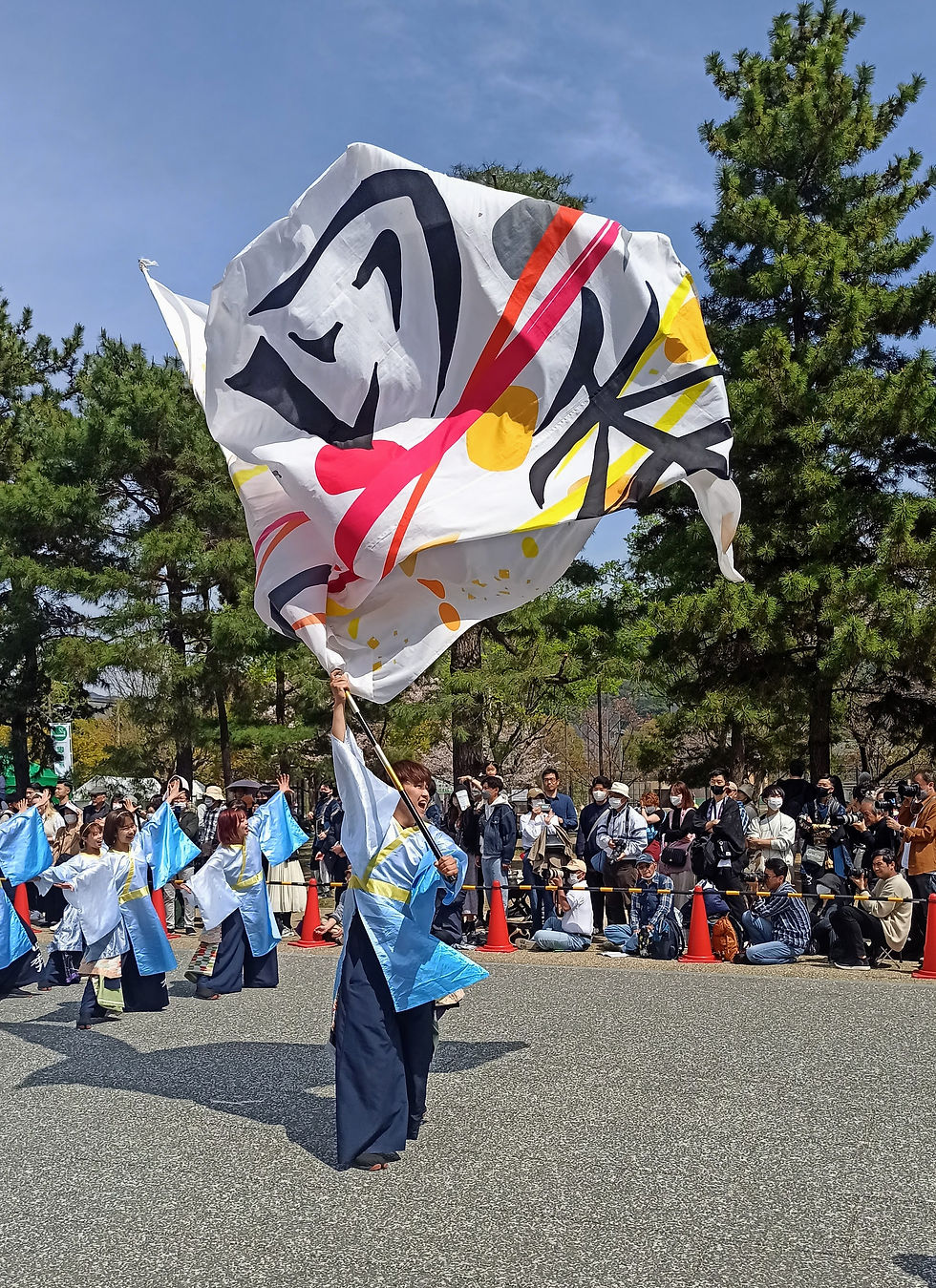My experience at the Sakura Yosakoi Matsuri in Kyoto
- sofiamagoni56
- Apr 19, 2023
- 7 min read
Japan is renowned for its festivals, known as matsuri, which occur throughout the year and are present even in the most remote regions of the country. The Sendai Tanabata Festival, the Sapporo Snow Festival, and the Gion Matsuri in Kyoto, the festival of Yasaka Shrine, are amongst the most prominent ones. The latter is especially noteworthy since the giant flotes being paraded through the city annually in July are a sight to behold.
These festivals draw in a large number of visitors and host a variety of traditional events on a large scale. While the larger festivals, such as the Gion Matsuri, are undoubtedly worthy of their reputation, the smaller festivals - of which there are many - are also worth exploring. Today, I would like to introduce you to the Kyoto Sakura Yosakoi Matsuri, a lively and colorful festival featuring dances performed by various groups from all over Japan.
This text is divided into three chapters that cover different aspects of the Sakura Yosakoi experience. In chapter one, we'll explore the history and development of the Yosakoi dance style. Chapter two explores the specifics of the Kyoto Sakura Yosakoi. Finally, in chapter three, we'll delve into my own personal experiences at the festival and why I believe it's an event worth attending.
Let's get into it!

Group "岡山うらじゃ連 楽鬼"
1. What is Yosakoi?
The first Yosakoi Matsuri was held in 1954 in the city of Kochi. "Yosakoi" is an old word meaning "come and visit at night", which greatly exemplifies the lively ambiance of the festival. It originated in the desire for economic revival and regional development during the post-war recession in Japan. Since its humble beginnings in Kochi, it has spread to many areas in Japan and even to certain countries worldwide.
Apart from being a festival, the Yosakoi is first and foremost a style of dance that can be performed all year round throughout Japan. The style integrates traditional moves, music, and costumes with modern elements, creating a mesmerizing and energetic performance. Numerous Yosakoi schools and school clubs create their own choreographies and communicate their identity through Yosakoi dance at festivals and school events. The groups performing usually consist of a high number of both men and women of all ages.
A regular performance encompasses original music that suits the choreography, usually lasting three to five minutes. It involves original costumes, props, and one or two announcers who guide the audience through the performance, sometimes even performing the song live.
Each group cultivates and is proud of its own identity, which is first visible by its performance attire. Traditional clothing styles like the Yukata are typical clothing choices for most groups, but every group has a different spin on the design. They experiment with color and fabric design and add innovative elements such as headbands, incorporating ethnic or contemporary fashion with traditional garments. It is not uncommon for them to include a costume change within the choreography.
Wooden clappers, called naruko or "bird rattle", are the primary requisites for the dance. Having their origin in agriculture, they produce a distinctive rattling sound, which is especially impressive when thirty people perform it in unison. Flags, fans, drums, or umbrellas are also common props, colored and decorated according to the style of each group, representing their identity.

Group "京都西陣阿国" - using a variety of props apart from the naruko
Group "夢色歌留多" - the flags sway through the air as if they weigh nothing
While one of the key elements of the Yosakoi style is the freedom of the dances and individual expression, specific regulations must be adhered to classify it as Yosakoi.
The choreography must include sequences that make use of the naruko. The naruko can be used for as short amounts of time as wished and then tucked away into the belts of the costumes. The groups must move forward at a slow pace, akin to a parade. While some places follow through with this rule, not all venues do. Additionally, the music of each team must incorporate a segment of the "Yosakoi Naruko Dancing" song by Takemasa Eisaku. This song is the foundation for all Yosakoi dancing, and while not all festivals abide by this rule, the original Matsuri in Kochi requires dancers to include at least a section of this song. The announcers typically call out parts of the song during the performance, predominantly "Yotchoreyo" and "Yoiyasa," creating a jubilant and energetic atmosphere.
2. The Sakura Yosakoi
Although Yosakoi festivals may be held throughout the year, Sakura Yosakoi, commonly referred to as "Sakuyosa", is an event that can only be experienced in Kyoto on a single weekend in April. In 2005, students sought to liven up Kyoto and initiated the festival. To this day, the majority of the participating groups are university students from various regions of the country who are members of special Yosakoi teams. The 2023 Sakura Yosakoi marked the 19th iteration of the festival, with 120 groups performing at four distinct venues: Nijo Castle, Okazaki Park, Umekoji-Park, and Zest Oike. Be advised that there might be an entrance fee applicable, such as at Nijo Castle.
Further details regarding the festival can be found on the official Sakuyosa homepage, accessible at http://www.sakuyosa.com/!
3. My experience at the Kyoto Sakura Yosakoi
Since information about the locations and times is a little hard to find online, I missed the first day of the dances. After asking my host family I went on the second day, which was a Sunday, to the dances at the Heian Jingu Shrine, or more specifically, Okazaki Park in front of it. According to a friend of mine, the site there is the prettiest and very picturesque - and it did not disappoint.
Sunday was, as the name suggests, a sunny day. Upon my arrival, the towering posts of the Heian Jingu Shrine could be seen beyond the masses of people, and the striking contrast between the vivid red of the shrine and the clear blue sky was a truly impressive sight.

The Outemmon Gate at the Heian Jingu Shrine
As the festival can be overwhelming at first, with loud music blasting and the sun shining bright, I suggest getting one of the program brochures they hand out for free at the information desk. The brochure contains the festival's history, the different locations, a timetable, and the names and contact information of the performing groups. This way, you can support them if you want to. Although the brochure is written entirely in Japanese, you may ask the friendly staff at the information desk for immediate assistance if you have an urgent question. Alternatively, you can opt for services such as Google Translator, which has a built-in photo-to-text translation feature. But even without these resources at hand, the timetable of the various performing groups can be understood even without proficiency in the Japanese language.
At the Heian Jingu location, they also give out flyers with a site plan, showing the locations of the food stalls on the western side of the park. That's right, in true festival fashion there are about twenty different tents offering everything your heart could possibly desire and more. I only ate a box of freshly made Takoyaki, but there was also Yakisoba, Karaage, Kebab, Hiroshima Okonomiyaki, Crepes, Kakigori, or fresh juice - all in all, a wide variety of foods that will certainly fit everyone's tastes.
The festival's main attraction is the performances. In total, there were two stages: The southern one, which is the first one you see when you enter the park from the Grand Torii on Jingu-michi and which is a little bit smaller, and the main stage.
In general, the groups performing on both stages are the same. The main thing that differentiates them though is that the main stage is much longer and allows for parade-like choreographies, which move forward as their song continues and are the staple of Yosakoi dances. From 11:00 to 13:30, you can enjoy those dances with intricate choreographies and impressive flag-waving. After that, the main stage transforms into a sitting area, and the performances continue with dances similar to those of the southern stage.
Group "夢源風人" - moving forward and backward in a parade-like fashion
As the first festival in Japan that I attended, I didn't really know what I was to expect of the Sakura Yosakoi groups. I arrived in the midst of the first few groups performing and was immediately astonished by the skill of the dancers, the absolute beauty of their costumes, how individual all of the groups were while still moving in complete synchronization, the ever-smiling faces of the dancers, and just how artistically beautiful everything was executed. Especially the giant flags being waved in the back fascinated me to no end. They must be very heavy and require a lot of skill to make it seem like they simply sway in the wind.
From groups with a more "traditional" vibe to them, with beautiful costumes resembling medieval clothing and elegant music, to groups dancing to modern electronic music and performing crazy cool acrobatics (mainly group GARAN43/35°), and everything in between - there was so much to see. Together with the white petals of the Sakura falling down like snow in the soft breeze, this created a captivating and almost other-worldly image of twirling hair and long sleeves backed by big banners and the gorgeous gates of the Heian Jingu Shrine.
Additionally, apart from the good memories, I got a sunburn as a souvenir. Remember to bring sunscreen, enough water, and a hat.

Group "京炎そでふれ" - energetic dancer with a flag
Thank you for reading and as always, if you want to connect with me you can find me on Instagram @haito.in.japan!
~
This post was created using information from the following web pages:
Special thanks to 岡山うらじゃ連 楽鬼, 京都西陣阿国, 夢色歌留多, 夢源風人, and 京炎そでふれ!
*Since I am currently taking pictures with my phone, I apologize for the lacking quality.



コメント